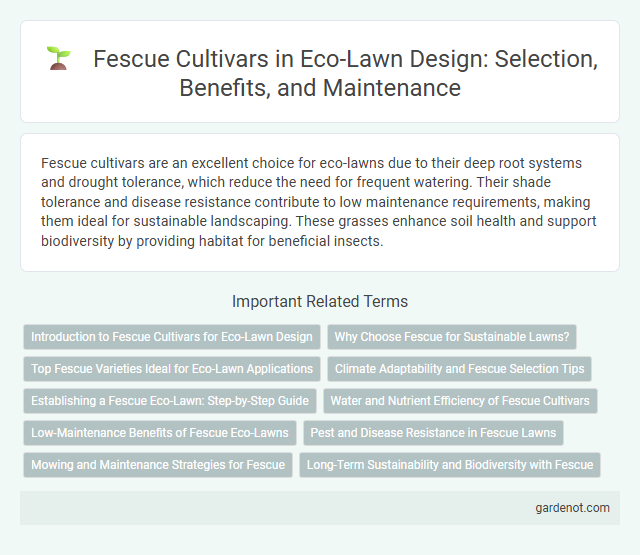Fescue cultivars are an excellent choice for eco-lawns due to their deep root systems and drought tolerance, which reduce the need for frequent watering. Their shade tolerance and disease resistance contribute to low maintenance requirements, making them ideal for sustainable landscaping. These grasses enhance soil health and support biodiversity by providing habitat for beneficial insects.
Introduction to Fescue Cultivars for Eco-Lawn Design
Fescue cultivars, particularly fine fescues like chewings, hard, and creeping red fescues, are ideal for eco-lawn design due to their drought tolerance and low maintenance requirements. These cultivars thrive in shaded areas and poorly drained soils, making them suitable for sustainable lawn alternatives that reduce water usage and chemical inputs. Their deep root systems enhance soil health and promote carbon sequestration, supporting environmental sustainability goals.
Why Choose Fescue for Sustainable Lawns?
Fescue cultivars thrive in low-fertility soils and require minimal water, making them ideal for sustainable lawns. Their deep root systems improve soil health, reduce erosion, and increase drought tolerance. Choosing fescue supports eco-friendly landscaping practices that conserve resources and promote biodiversity.
Top Fescue Varieties Ideal for Eco-Lawn Applications
Top fescue varieties ideal for eco-lawn applications include hard fescue, chewings fescue, and sheep fescue, known for their drought tolerance, low maintenance, and fine texture. Hard fescue excels in poor soil conditions and shade, making it suitable for sustainable landscaping. Chewings and sheep fescues contribute to soil erosion control and biodiversity, promoting environmentally friendly turf management.
Climate Adaptability and Fescue Selection Tips
Fescue cultivars exhibit strong climate adaptability, thriving particularly well in temperate zones with moderate rainfall and cooler temperatures. When selecting fescue for an eco-lawn, prioritize drought-resistant varieties such as tall fescue and chewings fescue, which maintain green color and density under water stress. Choose cultivars with deep root systems and disease resistance to enhance sustainability and reduce maintenance in varying environmental conditions.
Establishing a Fescue Eco-Lawn: Step-by-Step Guide
Establishing a Fescue eco-lawn begins with selecting a drought-tolerant Fescue cultivar such as Kentucky Blue or Tall Fescue for enhanced resilience and low maintenance. Prepare the soil by aerating and ensuring proper pH balance between 6.0 and 7.0 to optimize nutrient uptake for robust growth. Sow seeds evenly at a recommended rate of 4-6 pounds per 1,000 square feet, water consistently until germination, and gradually reduce frequency to encourage deep root development and sustainability.
Water and Nutrient Efficiency of Fescue Cultivars
Fescue cultivars demonstrate superior water use efficiency due to their deep root systems, which enhance drought tolerance and reduce irrigation requirements by up to 40%. These grasses efficiently uptake and utilize nutrients, particularly nitrogen and phosphorus, minimizing fertilizer runoff and promoting sustainable lawn management. Studies show that fine fescues maintain high photosynthetic rates under nutrient-limited conditions, supporting their role in eco-friendly landscapes.
Low-Maintenance Benefits of Fescue Eco-Lawns
Fescue cultivars in eco-lawns offer exceptional drought tolerance and reduced mowing frequency, significantly lowering maintenance efforts. Their deep root systems enhance soil health and improve water retention, resulting in resilient, low-input landscapes. These eco-friendly lawns thrive with minimal fertilizer and pesticide use, promoting sustainable yard care practices.
Pest and Disease Resistance in Fescue Lawns
Fescue cultivars exhibit strong pest and disease resistance, making them ideal for eco-lawns that require minimal chemical intervention. Their natural resilience to common turf pests such as chinch bugs and fungal diseases like brown patch reduces the need for pesticides, promoting a healthier lawn ecosystem. Selecting disease-resistant Fescue varieties enhances lawn durability and sustainability, supporting eco-friendly landscaping practices.
Mowing and Maintenance Strategies for Fescue
Fescue cultivars thrive with mowing heights maintained between 2.5 to 3.5 inches, promoting deep root development and drought resistance in eco-lawns. Regular mowing intervals of 7 to 14 days prevent excessive clippings and reduce stress on Fescue grass, ensuring density and weed suppression. Implementing maintenance strategies such as precise irrigation and targeted fertilization further enhances the sustainability and health of Fescue-based eco-lawns.
Long-Term Sustainability and Biodiversity with Fescue
Fescue cultivars, known for their drought tolerance and low nutrient requirements, contribute significantly to long-term sustainability by reducing water usage and minimizing fertilizer runoff. Their deep root systems enhance soil structure and promote biodiversity by supporting beneficial microorganisms and pollinators. Integrating fescue in eco-lawns fosters resilient landscapes that require less maintenance while sustaining local ecosystems.
Fescue cultivar Infographic

 gardenot.com
gardenot.com